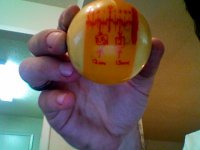great post scott, brings a point to mind that i will expand on.....
Matthias...To add to what Steve and Ingo told you, here is another viewpoint.
Take a hard look at a red circle CB. The size of the red circle (3mm/1/8") is the size of the contact area between the tip and CB. It also represents a "tip of english". The size of the contact area doesn't change, regardless of how hard you shoot, or where you aim on the CB. Try setting up shots where the OB is no more than 2 feet from the pocket, and the CB is no more than 2 feet from the OB. Start with straight in shots, as Steve advised, and practice stop, draw and follow. Then shoot the same straight in shots, but adding just 1 tip (you can go three tips out at maximum sidespin) of english, with no top or draw. Do them at different speeds and you'll start noticing how much the CB moves offline, and how to adjust your aim, so you can compensate for the squirt of the CB, and still pocket the OB.
Hope this helps.
Scott Lee
www.poolknowledge.com
EXCELLENT POINT!!!!! This is not COMMON knowledge imop........as most I see say 2 tips english and their "measurment" is based off the actual whole width of the tip.....this is where we hear the misconception that 3 tips is max english, and being a larger unit that way its a wayyyyy less accurate tip displacement technique
The english necessary to successfully make the outcome do what you want,
is often quite a bit less than what is actually applied.
For example: CB on center of head string and OB on the center diamond against the foot end rail.......
That shot I GIN routinely.......its how I judge the effective CB SQUIRT that the shaft/tip applies to the CB or if you prefer, the DEFLECTION level of the shaft.
I shoot normally with a 12mm tip on a cue/shaft thats very LD or low CB squirt......the maximum tip english i can get without going past the sides of the stripe (miscue point) is 4.5 tips left or right..........the stripe on my centennials is 27mm wide.
I shoot it with a striped ball w/stripe VERTICAL, the stripe width being the accepted general miscue limit which helps as a visual aid/reference.
Using the 12mm old growth shaft I make it by striking the CB @ 1.5 tips or 5.5mm from the exact center of the CB............
Using a 13mm Huebler with original shaft I make it using 2 tips english or 7mm from the exact center of the CB..... SO I AM WAY INSIDE THE MISCUE LIMIT as the side of the tip is even with the left or right edge of the stripe depending on which pocket I'm making the shot in.
I refer to my standard use of english calling it CORE ENGLISH and thats staying within a 2 tip range or within 7 mm of the exact center of the CB......there are some shots that i will displace it 3 tips but its not all that often.
This is why i enjoy shooting with my normal player (12mm) so much as I can get the necessary english needed without having to stray very far from center.......
smaller tip displacement = less CB squirt =Straighter CB PATH=Less Compensation of aim=way accurate
I see this LAGNIAPPE ENGLISH (meaning extra) routinely applied by many players, and i liken it to bunting and having to build up higher velocity so as to be able to BRAKE to "X" speed that you want....higher speed shot is LESS ACCURATE.........EXTRA UNNECESSARY ENGLISH IS ALSO LESS ACCURATE
This is also one reason you see the aftermarket LD shafts being so popular as it helps to dampen the effects of them using SO MUCH ENGLISH.......
all that Lagniappe English does is MAGNIFY your current shafts effects on CB squirt......
English is similar to SALT.........its the best seasoning we can use to modify and BETTER the taste of our game..........but when you use too much salt the food will most definately taste like $hit.
Included is a photo of a diagram I drew on an extra offbrand ball i have. The no name brand ball has a wider stripe than the centennials I use so I shaded in the excess stripe as I don't feel like putting permanent marker on my good set. I transferred my measurements of the shot with both the 12mm low CB squirt old growth shaft and the 13mm huebler maple shaft from the markings chalk marks on the centennials onto the cheap ball.
Long story short (before Steve gets on board and says what i just explained in two sentences lol) be aware and learn the MINIMUM QUANTITY of english necessary to successfully complete the shot. Exceeding the minimum quantity adversely affects your shots accuracy no matter what kind of holy grail shaft we are using.
For this is the reason we teach beginers to play without english to start so they build on their ZERO references, meaning you can't know what 1+ 3 is without knowing what ZERO is.
When you learn what zero can do then you can add the numbers to it and effectively do the "math" correctly without catching any ghosts in your machine.
Zero is king of our known universe,
-Grey Ghost-
